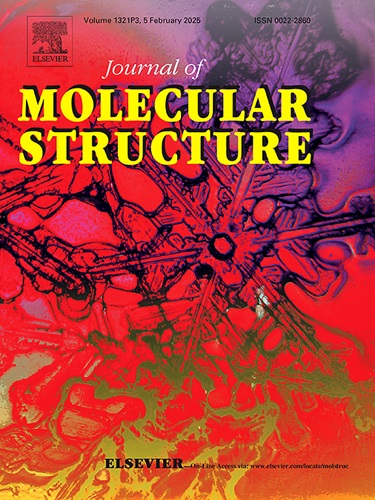靶向Nur77的1-(4-(7-羟基-4-氧- 4h -铬-3-基)苯基)-3-芳脲衍生物的合成及生物学评价
IF 4
2区 化学
Q2 CHEMISTRY, PHYSICAL
引用次数: 0
摘要
作为我们正在进行的抗肿瘤Nur77调节剂的一部分,我们设计并合成了一系列新的1-(4-(7 -羟基-4-氧- 4h -铬-3-基)苯基)-3-芳脲衍生物7a-7p。所有化合物均通过1HNMR、13CNMR和高分辨率质谱(HRMS)进行了表征。体外观察其对HepG2和MCF-7细胞的抗增殖活性。其中,化合物7k对HepG2和MCF-7细胞的IC50值分别为3.93±0.54 μM和4.75±0.48 μM,对正常肝细胞L-O2的IC50值均大于50 μM;12.7. 分子对接研究表明,具有多种生物学功能的孤儿核受体Nur77是化合物7k的直接结合靶点。此外,7k还以时间/剂量依赖的方式上调Nur77的蛋白水平。菌落形成和划痕实验结果也表明,7k对HepG2的增殖和迁移有抑制作用。此外,7k诱导PARP裂解,增加BAX蛋白水平,激活caspase 3。综上所述,7k通过抑制HepG2细胞增殖和诱导凋亡发挥抗癌作用。本文章由计算机程序翻译,如有差异,请以英文原文为准。

Synthesis and biological evaluation of 1-(4-(7-hydroxy-4-oxo-4H-chromen-3-yl)phenyl)-3-arylurea derivtives as anti-tumor modulators targeting Nur77
As part of our ongoing work on anti-tumor Nur77 modulators, a series of novel 1-(4-(7‑hydroxy-4-oxo-4H-chromen-3-yl)phenyl)-3-arylurea derivatives 7a–7p were designed and synthesized in six steps. All compounds were characterized by 1HNMR, 13CNMR, and high-resolution mass spectrometry (HRMS). Their anti-proliferation activities against HepG2 and MCF-7 cells were evaluated in vitro. Among these, compound 7k showed significant inhibitory activity against HepG2 and MCF-7 cells with IC50 values of 3.93 ± 0.54 μM and 4.75 ± 0.48 μM respectively, the IC50 value of normal liver cell L-O2 is greater than 50 μM, SI > 12.7. Nur77, an orphan nuclear receptor with diverse biological functions, was identified as a direct binding target of compound 7k, as suggested by molecular docking studies. Moreover, 7k also upregulated the protein level of Nur77 in a time/dose-dependent manner. The results of colony formation and scratch assay also showed that 7k inhibited the proliferation and migration of HepG2. Additionally, 7k induced PARP cleavage and increased the protein levels of BAX and activated caspase 3. In conclusion, 7k exerts anticancer effects by inhibiting proliferation and inducing apoptosis in HepG2 cells.
求助全文
通过发布文献求助,成功后即可免费获取论文全文。
去求助
来源期刊

Journal of Molecular Structure
化学-物理化学
CiteScore
7.10
自引率
15.80%
发文量
2384
审稿时长
45 days
期刊介绍:
The Journal of Molecular Structure is dedicated to the publication of full-length articles and review papers, providing important new structural information on all types of chemical species including:
• Stable and unstable molecules in all types of environments (vapour, molecular beam, liquid, solution, liquid crystal, solid state, matrix-isolated, surface-absorbed etc.)
• Chemical intermediates
• Molecules in excited states
• Biological molecules
• Polymers.
The methods used may include any combination of spectroscopic and non-spectroscopic techniques, for example:
• Infrared spectroscopy (mid, far, near)
• Raman spectroscopy and non-linear Raman methods (CARS, etc.)
• Electronic absorption spectroscopy
• Optical rotatory dispersion and circular dichroism
• Fluorescence and phosphorescence techniques
• Electron spectroscopies (PES, XPS), EXAFS, etc.
• Microwave spectroscopy
• Electron diffraction
• NMR and ESR spectroscopies
• Mössbauer spectroscopy
• X-ray crystallography
• Charge Density Analyses
• Computational Studies (supplementing experimental methods)
We encourage publications combining theoretical and experimental approaches. The structural insights gained by the studies should be correlated with the properties, activity and/ or reactivity of the molecule under investigation and the relevance of this molecule and its implications should be discussed.
 求助内容:
求助内容: 应助结果提醒方式:
应助结果提醒方式:


